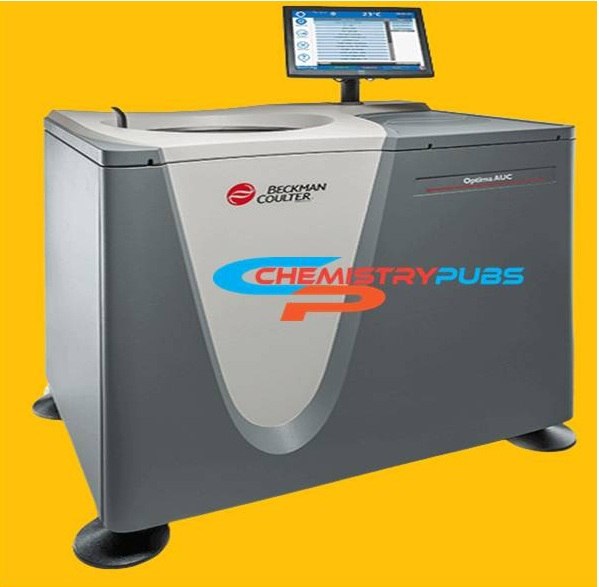Ultracentrifuge is a modern and complex type of centrifuge that can operate at an extremely high speed and separates smaller molecules easily. It has good speed ranges from 60,000 rpm to 150,000 rpm. This type of centrifuge is very suitable to perform more advanced operations. The samples can be operated by this apparatus either in batches or as a continuous flow system. It has a heat-controlling system which makes it more suitable to operate.
Principle of Ultracentrifuge
The principle of this equipment follows the sedimentation principle, which shows that the denser particles of the objects settle down faster when compared to less dense particles under gravity. It takes a larger time to sediment particles under gravity, and that is why an additional force is required to apply for running the sedimentation process.
The sample can be rotated about an axis, and generate a perpendicular force, called centrifugal force, which acts on different particles on the sample. It takes a long time for moving smaller particles than larger particles.
It can be possible to move the less dense molecules toward the center of the tube than the more dense molecules. The larger and denser particles settle down. These particles can form pellets at the bottom of the tube. On the other hand, the smaller and less dense particles of the sample remain either suspended in the supernatant or float on the surface.

Types
Ultracentrifuge is generally two types which description is given below:
1. Analytical ultracentrifuge
This versatile and robust method of this equipment has the ability to the analysis of various particles present in the sample. The detection system of this centrifuge consists of a monitor that shows the spinning and position of the particles to determine the sedimentation coefficient that aids in the analysis of particles based on size, shape, and mass.
The molecular mass of a macromolecule can be performed by a sedimentation velocity approach or sedimentation equilibrium methodology. The sedimentation coefficient can be determined by this method which is very important for characterizing the changes in size and shape of macromolecules to change experimental conditions.
The sedimentation coefficient helps to determine the properties of different molecules. This system is suitable to observe the absorbance, interference, and fluorescence of the sample during the experiment. The properties of biomolecules like proteins and nucleic acids can be identified by this technique.
2. Preparative ultracentrifuge
This type of centrifuge is very suitable used for the isolation and separation of particles in a sample by the process of centrifugation. It consists of many tubes where the analysis is done during the centrifugation process. This technique can be used for different types of centrifugation processes like differential centrifugation, density gradient centrifugation, and isopycnic centrifugation.
The various constituents of the sample can be separated on the basis of their density or their size by helping this technique. The particles of a sample can be separated on the basis of their density by applying density gradient centrifugation and isopycnic centrifugation technique.
Instrumentation of Ultracentrifuge
The swinging bucket rotor of the ultracentrifuge machine generates the highest concentration of particles by applying the centrifugal force in vertical rotors align with the position of the tubes. The power drive unit helps to spin the rotor holding cells or tubes which contain the solution of molecules or suspension of various particles.
It can produce heat during the operation of ultracentrifuge at high speeds. It consists of a two-dimensional comparator with a printing desk calculator, interference, and absorption optical systems. A hand refract meter, a gradient-forming device, a recording spectrophotometer with a flow cell, and a fraction collector are present in a preparative-type ultracentrifuge system.
Procedure of Ultracentrifuge
The temperature and time should be set in the ultracentrifuge before this process is started. Firstly, the sample is taken in analytical cells which must be placed inside the ultracentrifuge. The lid is closed, and the technique is started. The centrifugal force is then applied to migrate the constituent of the sample through the solvent radially outwards from the center of rotation. It can be determined The molecule’s distance from the center by the Schlieren optical system.
A graph is derived by putting the value of solute concentration versus the squared radial distance from the center of rotation, based on which the molecular mass is determined. The sample particles can travel through the gradient until they reach a definite point at which their density matches the density of the surrounding medium. It can be possible to remove and separate the fractions by this process.
Applications of Ultracentrifuge
This technique is very essential to determine the stoichiometries of various macromolecules like molecular masses, size, etc. It allows the detection and characterization of macromolecular conformational changes owing to changes in temperature, pH, and various environmental factors. This process can be applied in biological systems for a pelleting fraction of cell organelles like mitochondria, ribosomes, and even viruses. It can be possible to determine the densities of various macromolecules by this technique. Biological crude can be extracted and purified by this ultracentrifugation.
Precautions of Ultracentrifuge
It should be followed the manufacturer’s manual at the time of running this susceptible device. The rotors of this apparatus should be handled carefully and routinely observed for signs of corrosion and cracking. It must keep the volume of the sample in the tubes while adding the tubes to the rotors. The number of tubes which keep in this device should always be balanced. It must be remembered that the speed of the rotor should not exceed the assigned value.
References
1.Ralston, G. B. (1993). Introduction to analytical ultracentrifugation (Vol. 1). California:: Beckman.
2.Schachman, H. K. (2013). Ultracentrifugation in biochemistry. Elsevier.

